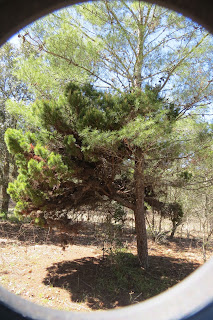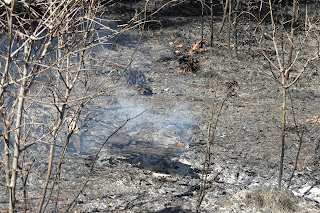Inverness, Florida March 21, 2017
Having just visited Fort Cooper State Park (see separate blog entry on Fort Cooper in March 2017), Jan and I decided to visit the much larger (50,000 acres, about one third of the Withlacoochee State forest) Citrus Wildlife Management Area (CWMA). It is host to some unique habitat (sand hills and caves) and species, red-cockaded woodpeckers, gopher tortoises and indigo snakes.
There are many trails in this huge tract, and we chose one that had some interesting sightings on Ebird. CWMA is the 8th best birding spot in Citrus County in terms of number of species. Another species of interest to me is Bachman's Sparrow, which was seen in the tract as late as June of this year. My interest in species named after Bachman was piqued when I visited the Magnolia Estate in Charleston, SC in December. Rev. Bachman hung out here and hosted J.J. Audubon on several occasions and he worked closely for decades with Maria Martin, Bachman's sister in law.
The sparrow and the short-tailed hawk are birds that have eluded me in Florida, so I intend to return to this tract to find these two species and others. Whooping Cranes regularly visit the lakes just to the east of CWMA. The Inverness lakes host a variety of water-loving birds.
Male Pond Hawk Dragonfly
Rubyspot Damselfly (same group as Jewelwings), possibly Smoky Rubyspot, Hetaerina titia .
Rubyspot Damselfly, possibly American, Hetaerina americana.
My luck, that the Rubyspots I observed had none of the ruby colouring which characterizes this genus. Identification is very difficult without these markings. We had also been seeing many large and colourful Swallowtail Butterflies, including:
Pipevine Swallowtail, Battus philenor
We then drove to the CWMA, parked close to the trail we had chosen and started to walk. This Sand Pine, a Pinus clausa small pine of very sandy areas. The local subspecies is known as Ocala Sand Pine. It needs fire to reproduce and to maintain populations, which, coincidentally, the Florida State conservation staff decided to show us in person.....
so recent that is was still smokingin some places,
making life difficult for this Prickly Pear Cactus, above.
As you can see, pine cones not only survive the fire, but the seeds inside needs fire for germination. Of course, Winston, below, was both unimpressed with the heat and lack of shade (the pink tongue searched longingly for water_.
Some of the stumps of unwanted trees were still burning (above and below)
I read online a paper that declared the very noxious invader originally from South America, below, as having an uncertain "fire status". It was thought that the Tropical Soda Apple, Solanum viarum, would only be "top killed" by fire, since the roots survive. The photo may indicate that even the above-ground portion may survive fire OR the plant quickly regenerates and blooms! I have featured this plant in a previous blog, where you can see the fruit. The observant reader may notice the genus name Solanum, as belonging to the same group as the Nightshades, Tomatoes and Potatoes (Solanacaea).
We did have a great walk, found a few birds, like the Eastern Towhee,
| Pipilo erythrophthalmus, already occupying the fire-resistant shrubs. We all survived the sunny warm day, enhanced by the burn. |















No comments:
Post a Comment
Help with "Comments"
1) Click on "Comments" at the end of the blog entry that you wish to comment on.
2) Type your comment in the field provided.
3) Under your comment choose "Name/URL". Type your name (first and/or last names) in the box provided. Choosing "Name/URL" will ensure that you do not need to "register" before leaving a comment.
4) Click "Preview" to see how your comment will look on the site if you wish, otherwise skip to step 5.
5) Click "Publish" to submit your comment.
Please note that all comments are moderated so I will review them before they are published.
I look forward to receiving your comments.